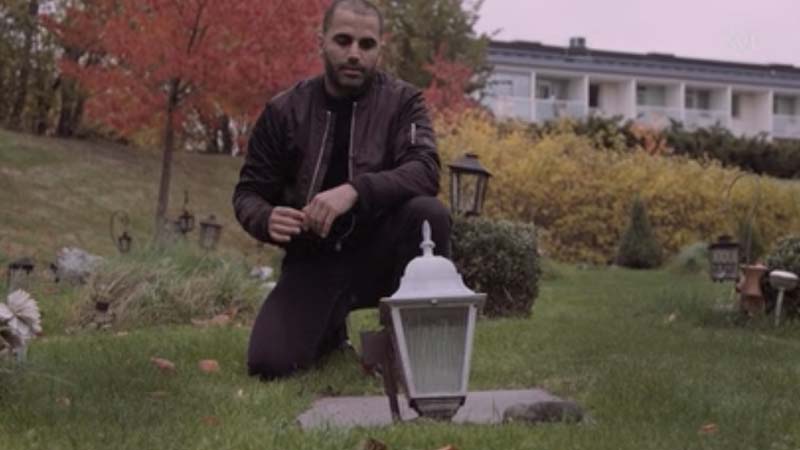Out of a thousand children of the parents who were members of the Mujahedin-e Khalq (MEK), each of them suffered a different fate. The documentary “Children of Camp Ashraf” depicts the adventures of four of these children who were smuggled to Sweden and now they are Swedish citizens. However, in this documentary there are references to the lives of some other children: child soldiers who were victims of Massoud Rajavi’s destructive cult. Ehsan Shakeri was a child soldier of the Cult of Rajavi who was not left free by the MEK even after he had departed Camp Ashraf, Iraq.
Sara Moien’s documentary, Children of Camp Ashraf, narrates the story of Atefeh Sebdani, Amir Yaghmai, Hanif Bali and Parwin Hosseinnia. In a scene of the film, Amir Yaghmai is on his knee near the grave of his friend, Ehsan.
Who was Ehsan?
Ehsan Shakeri was living in Sweden together with his mother and daughter when the recruiters of the Mujahedin khalq deceived him to join the MEK’s so-called National Liberation Army, in Iraq. He became a member of the MEK’s militia force –better said, child soldiers but shortly after, he came to know that the repressive ruling of the Rajavis over the MEK is not tolerable. He criticized the group and he was labeled as mercenary of the Iranian government. The labeling was continued by the MEK propaganda until Ehsan killed himself.
The young emotional Ehsan could not bear the military life in the MEK where he had to receive military trainings, he had to attend self-criticism sessions and he had to forget family life. He had missed his mother and sister. Thus, he began questioning the commanders and eventually he became the problematic element for his commander, Zhila Deihim.
“Ehsan asked to leave the MEK and go back to Sweden several times but in response he was punished by Zhila Deihim,” former member of the MEK Reza Gooran writes in his memories about his involvement in the MEK. “Zhila jailed Ehsan in solitary confinement in Street 400 of camp Ashraf, beating him and insulting him”. Reza Gooran was in the same unit with Ehsan after they both left Camp Ashraf and joined the American temporary camp for MEK’s defectors (TIPF), in 2004.
Ehsan was good in English, so the American forces employed him as their interpreter. However, Zhila Deihim did not leave Ehsan alone, in TIPT. She used to come there to visit Ehsan asking him to spy on the other defectors who resided there. Therefore, Ehsan was called spy by his peers and consequently the Americans fired him just because the MEK commander wanted him to work as their mercenary.
Actually, Ehsan was not a spy but Zhila Deihim wanted him to be. Ehsan just wanted to get back to his family. Reza Gooran tried to support him in TIPF but both of them were under pressure, previously in the MEK and now in TIPF. “Ehsan was like my younger brother, I really loved him,” Reza says.
Amir Yaghmai, former child soldier who had left the MEK too and was in TIPF at the time, confirms Reza Gooran’s account in the Club House room, attended by former members and former child soldiers of the MEK. He says, “I was in TIPF with Ehsan and Reza. Reza was so supportive to Ehsan. The American forces had jailed Ehsan in solitary confinement for one month. Then he was released and he went to Iran inevitably and from there he immigrated to Sweden. The MEK labeled him as a mercenary of the Iranian government publishing several announcements to accuse him of being the agent of the Iranian intelligence in its websites.”
Ehsan Shakeri was announced as the agent of the Islamic republic by the MEK just because he had gone to Iran and had stayed there for a short time before moving to Sweden. Based on the MEK rhetoric, returning to Iran equals with working with Iranian government which is the enemy of the group.
“In 2009, –I do not mean that it was just because of the MEK but—he was under severe mental pressure and finally, as what Reza said, we heard that Ehsan hanged himself by the neck in the jungles of Sweden,” Amir Yaghmai says. “He was a child of ours (Mujahedin); his father had been killed. His mother and sister live in Sweden. The MEK shot him by calling him “mercenary! Mercenary! mercenary! I was the only witness there. I saw what he endured. If I were in his shoes at the time, I might have gone to Iran too. Once he came to Sweden trying to build a new life, the MEK constantly published announcements against him.”
Ehsan was never a mercenary, neither for Iran nor for the MEK. He could not manage to endure such accusations. He committed suicide after enduring too much mental pressure.
By Mazda Parsi


